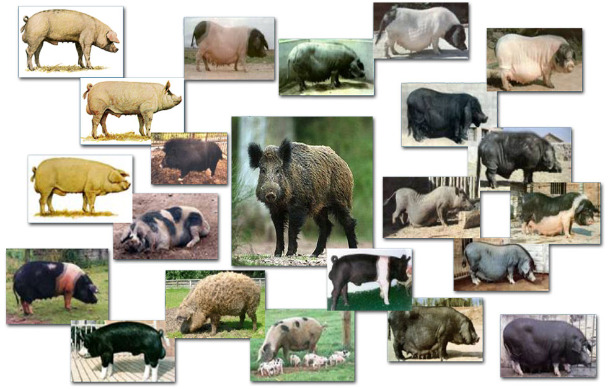Each pig has about 70 billions cells, each containing 38 chromosomes in the nucleus of each cell. Two of the chromosomes, called sex chromosomes, mostly dictate the sex of the pig: two X-chromosomes result in a female pig while one X-chromosome and one Y-chromosome result in a male. The remaining 36 chromosomes are called autosomes. All chromosomes are made up of two helically inter-wined strands of DNA, comprising alternate sugar and phosphate groups. Attached to the sugars and linking the two strands together in the ‘double helix’ re the bases adenine, cytosine, guanine and thymine. Adenine is always linked to thymine, and cytosine to guanine. A gene is a specific length of DNA. At its simplest the complete genetic information encoded in the DNA is called the genome and the first draft of the pig genome was published in 2009.


| A pig has about 70 billion cells | Each cell contains 38 chromosomes | Every chromosome contains coiled lengths of DNA | All along the DNA are specific genes wich control performance, conformation, etc |
Now, teams from 54 research groups, led by the Universities of Edinburgh (UK), Illinois (USA), Uppsala (Sweden) and Wageningen (Netherlands) have sequenced the entire genome of the pig. Results were published simultaneously in a set of papers in Nature, the Proceedings of the National Academies of Science and other prestigious journals in mid November.
The scientists compared the genome of the domestic pig with those of the wild boar and other ‘ancestors’ from different parts of Europe and Asia. They also compared the pig genome with the human, cow, dog, horse and mouse genomes.
The results show that the total size of the pig genome is 2.8 billion base pairs and contains 21,640 protein-coding genes. This is similar to other mammals, including humans. Interestingly, variation in the pig genome, even within commercial breeds, is more than twice that in humans.
Genome sequence data from wild pigs indicated that they originated in South East Asia some four million years ago. Studies found significant genetic differences between wild boar from Asia and Europe, the result of their separating from a common ancestor around a million years ago. The European and Asian populations then lost a significant amount of genetic diversity some 20,000 years ago, probably as a result of global cooling during the last ‘ice age’. The differences between the two populations are reflected in the genes of current day Western and Chinese breeds of domestic pigs, confirming that pigs were independently domesticated in western Eurasia and East Asia about 10,000 years ago. However, within the last 300 years there has been introgression from Asian genotypes into European genotypes. Based on the latest sequencing data it is estimated that some 35% of the today’s commercial pig genome, largely based on European genes, can be traced back to Asian breeds.

M. Groenen, 2008
Domestication resulted in significant changes in a whole range of traits. These include behavioural characteristics, reproductive performance, body size and shape, and skin colour. As an example, domestication resulted in pigs getting longer, as noted by Charles Darwin who gave a detailed account in his 1868 book 'The Variation of Animals and Plants under Domestication'. Basically, pigs became longer because pig keepers selected animals with a greater number of vertebrae. However, we now understand that three different genes are implicated - NR6A1, PLAG1 and LCORL which all originating in the European wild boar.
Some gene groups, such as immune and olfactory genes, are more evolutionarily evolved in the pig than those in humans and many other animals. Indeed, pigs have a highly developed sense of smell, which allows them to be used to find truffles, and the largest number of active genes for smell recognition of all animals that have undergone genomic sequencing to date, including dogs. On the other hand, pigs have fewer taste genes, enabling them to eat food that humans would reject, such as waste and scraps. They have a high tolerance for salt and for bitter substances and different perceptions of sweet and meaty food flavors compared with humans.
Other studies confirmed the suitability of the pig in unraveling the genetics of human disease. In total there were 112 DNA positions where the porcine protein has the same amino acid that has been implicated in a range of diseases including Alzheimer's disease, diabetes, obesity, and Parkinson's disease. In addition, data indicates that pigs also have twice as many interferon genes as humans, possibly giving high immune response against viral infection. Finally, there are fewer endogenous retroviruses in pigs than in most other animals supporting the suitability of pigs for organ transplantation studies.
In summary, in addition to improving our overall knowledge of the pig, the various new analyses of the porcine genome have important implications for commercial pig production. They will help define the genetic mechanisms that will enable improvement in overall efficiency, lowered production costs, better quality and improved disease tolerance/resistance. Future breeding programmes will be able to use the new knowledge through both conventional selection and genomic selection. The latter will be discussed in further articles.



